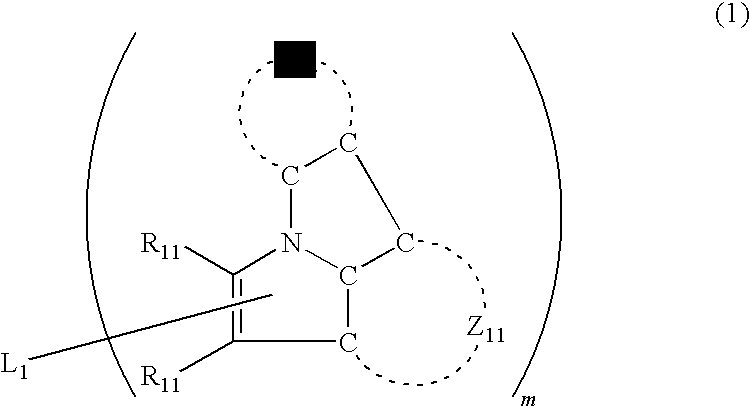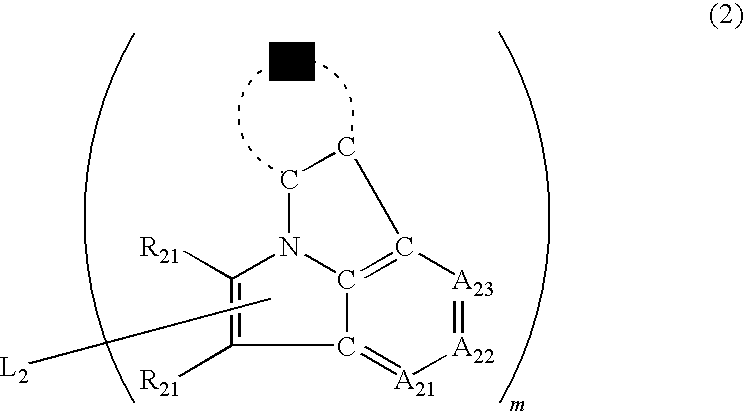Organic electroluminescence device
an electroluminescence device and organic technology, applied in the field of luminescence devices, can solve the problems of undeveloped devices in which high efficiency and high durability are compatible, and achieve the effect of low voltage and high luminous efficiency
- Summary
- Abstract
- Description
- Claims
- Application Information
AI Technical Summary
Benefits of technology
Problems solved by technology
Method used
Image
Examples
synthesis example 1
Synthesis of Illustrative Compound 1
[0448]Illustrative Compound 1 may be synthesized according to the following scheme.
[0449]Compound A was obtained in a yield of 82% by heat refluxing carbazole and 1-fluoro-2-nitrobenzene in the coexistence of potassium carbonate for 4 hours. The Compound A was reduced with a tin powder and converted into Compound B in a yield of 89%. The Compound B was allowed to react with sodium nitrite in a solvent of sulfuric acid (concentration: 18% by volume) and acetic acid (concentration: 82% by volume) at 0° C. and then condensed by means of heat decomposition, thereby obtaining Compound C in a yield of 62%. The Compound C was brominated in chloroform to obtain Compound D in a yield of 56%. The Compound D was allowed to react with normal butyllithium in a THF solvent. Triphenylchlorosilane was added thereto, and the mixture was allowed to react at room temperature for one hour. The reaction mixture was hydrolyzed with a sodium hydrogencarbonate aqueous so...
examples 1-1 to 1-55
and Comparative Examples 1-2 to 1-15
[0453]Devices were prepared in the same manner as in Comparative Example 1-1, except for changing the compound used in the light emitting layer to a compound shown in Table 1 and then evaluated. As a result, phosphorescence derived from each of the used light emitting materials was obtained. The obtained results are summarized in Table 1.
[Evaluation of Performances of Organic Electroluminescence Device]
(a) External Quantum Efficiency:
[0454]Each of the devices was subjected to light emission upon being impressed with a direct current using a source measure unit MODEL 2400, manufactured by Toyo Corporation. Its brightness was measured using BM-8, manufactured by Topcon Corporation. An emission spectrum and an emission wavelength were measured using a spectral analyzer PMA-11, manufactured by Hamamatsu Photonics K.K. An external quantum efficiency at a brightness in the vicinity of 1,000 cd / m2 was calculated based on these measured values according t...
examples 2-1 to 2-16
and Comparative Examples 2-2 to 2-6
[0458]Devices were prepared in the same manner as in Comparative Example 2-1, except for changing the compound used in the light emitting layer to a compound shown in Table 2 and then evaluated. As a result, phosphorescence derived from each of the used light emitting materials was obtained. The obtained results are summarized in Table 2.
TABLE 2DifferenceExternalin drivingquantumvoltage fromLightefficiencyComparativeemitting(relativeExamplelayervalue)2-1 (ΔV)ComparativeA-6B1.00—Example 2-1Example 2-1A-6C-11.32−1.54Example 2-2A-6C-31.24−1.33Example 2-3A-6C-51.37−1.69Example 2-4A-6C-61.41−1.58Example 2-5A-6C-121.47−1.72Example 2-6A-6C-131.44−1.60Example 2-7A-6C-141.52−1.66Example 2-8A-6C-151.39−1.71ComparativeA-6D-10.98−0.88Example 2-2ComparativeA-6D-21.09−0.95Example 2-3ComparativeA-7B0.98−0.12Example 2-4Example 2-9A-7C-11.42−1.81Example 2-10A-7C-31.39−1.57Example 2-11A-7C-51.45−1.73Example 2-12A-7C-61.44−1.64Example 2-13A-7C-121.54−1.78Example 2-14...
PUM
 Login to View More
Login to View More Abstract
Description
Claims
Application Information
 Login to View More
Login to View More - R&D
- Intellectual Property
- Life Sciences
- Materials
- Tech Scout
- Unparalleled Data Quality
- Higher Quality Content
- 60% Fewer Hallucinations
Browse by: Latest US Patents, China's latest patents, Technical Efficacy Thesaurus, Application Domain, Technology Topic, Popular Technical Reports.
© 2025 PatSnap. All rights reserved.Legal|Privacy policy|Modern Slavery Act Transparency Statement|Sitemap|About US| Contact US: help@patsnap.com



